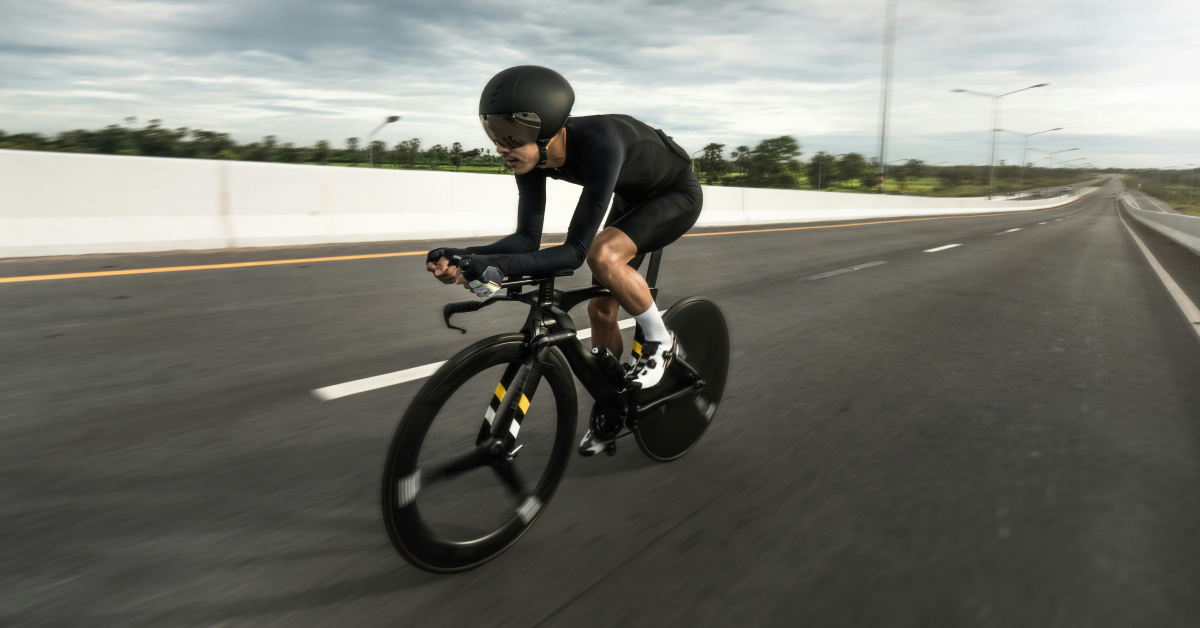Aerodynamic Optimisation for Triathlon Cycling
Aerodynamic optimisation is a balancing act. We try to find the best position and equipment in order to achieve our highest speed in a triathlon bike leg while using the fewest number of watts. We always need to keep in mind that the most aerodynamic position may not always be the best position for producing power—in fact, it rarely is. So, through a lot of trial and error, we need to find the best compromise between super-aero and super-efficient.
The power a cyclist generates will be used in four different ways. The first is the power required to overcome changes in altitude. On a flat course, this will be zero. If you’re on a steep hill, this will be a very significant percentage of your wattage. However, on a downhill section, this becomes negative.
The faster we ride, the more force we will feel from the air as we move through it. We want to optimise the size and shape of our bodies as presented to the wind.
A considerable amount of our valuable watts goes towards rolling resistance, which occurs literally where the rubber of our tyres meets the road. Road surface, tyre type, and tyre pressure will all have an impact.
Finally, we have acceleration. Once we’ve subtracted altitude watts, aero watts, and rolling watts from the watts produced, if any are left, we will accelerate. If there is a deficit, we will decelerate.
Position
When optimising position, we need to find the balance between aerodynamics, the ability to produce watts, and comfort. This is often a compromise. For age-group athletes, the ability to produce watts is the critical component for shorter distances, while comfort is a priority for longer race distances.
In aero testing, position affects equipment choices, and equipment choices can affect position. For example, we can place a rider in a position and then select the best helmet for that position. But if we start with the helmet, the optimal position may be different.
The biggest misconception in aerodynamics is that going lower is always faster. This is often true, but there is always a point at which a lower position begins to limit both power production and comfort.
Other major adjustments involve arm pad width and arm tilt. Very often it’s not the change itself that impacts aerodynamics, but the consequence of that change. For instance, narrow pads are thought to be more aero—and in isolation, they often are. But sometimes they prevent the rider from lowering their head, which can result in a greater aero penalty than the gain.
Helmet
Once we have found the optimal position, we need to select a helmet. A 10-watt difference between an aero helmet and a regular road helmet is not unusual. The challenge is that helmets are highly individual and dependent on the rider’s position. What works for one person may not work for another.
Additionally, in particularly warm races, a well-ventilated aero road helmet may be a smart compromise. We may only gain half the aero benefit, but avoiding overheating could allow us to finish the race strongly on the run.
Clothing
As with helmets, clothing is somewhat individual. There are a few general rules: tight is good; too tight is bad. In addition to restricting movement, overly tight clothing can sometimes negate the aerodynamic advantages of a suit. Once again, a difference of around 10 watts is not uncommon between a decent aero suit and a standard cycling jersey and shorts.
Sleeves that cover the upper arm generally test faster than bare skin.
Hydration
In long-distance triathlon, carrying hydration is essential, and bottle placement can impact aerodynamics, so it should be carefully considered. First, determine how much hydration you need to carry, then test different carrying options.
Many modern front-end hydration systems provide an aerodynamic benefit. Bottles positioned between the arms tend to be beneficial or neutral. Round bottles on the frame are usually a disadvantage. Bottles mounted behind the rider are typically neutral in aero terms.
Tyres
Although tyres don’t have a significant aerodynamic impact, they have a major influence on rolling resistance—the energy lost where the rubber meets the road.
A smart tyre choice can result in considerable savings in rolling resistance. While they may not be as exciting as deep wheels or sleek helmets, tyres should always be part of your race-day equipment considerations.
Wheels
While we haven’t discussed wheels in detail, they absolutely should be tested. A disc wheel can offer a solid aerodynamic advantage. Front wheels, however, should be selected based on the athlete’s handling ability.
While a rear disc might seem extreme on a windy day, it’s actually the front wheel that most affects bike handling. A very deep-section front wheel may offer more aerodynamic gains on paper, but if it makes the bike difficult to control—forcing you to fight the wind and steer constantly—those gains are effectively lost.
Testing
It’s fair to assume that most of us don’t have access to a wind tunnel to test our position, clothing, and equipment. However, we almost certainly have a local circuit or stretch of road that we ride regularly.
By experimenting with variations in equipment and positional tweaks on the same stretch of road—while accounting for changing wind and weather conditions—we can develop an intuitive understanding of what works and what doesn’t.
In fact, at the amateur level, these ‘real-world’ tests are arguably more insightful than anything done in a lab.





Leave a Reply